BY NAOMI INMAN
A leading genomicist, Dee Denver, from Oregon State University’s College of Science, is joining other scientists to find an earth-friendly approach to eliminating the crop crunching pale cyst nematode and golden cyst nematode. The microscopic parasites burrow into the roots of potato plants, sucking out essential nutrients and reducing crop yields by up to 80 percent.
The five-year, $3.2 million project, funded by the U.S. Department of Agriculture (USDA), has chosen an international team of scientists from Oregon, Idaho, New York, Canada, France and Scotland to study the potato probing parasites. A second OSU courtesy faculty member, Inga Zasada, is a nematode expert with the USDA’s Agricultural Research Service and says, “The nematode problem has a global reach… posing a significant threat to Northwest and U.S. potato industries.”
Denver explained the USDA’s key objective is to find less environmentally damaging strategies for controlling the pests, currently controlled by fumigation with methyl bromide, a highly toxic, ozone-layer-depleting gas. “We’re hoping to replace fumigation with integrated pest control strategies,” he said. “A key piece of that will be developing resistant potato varieties.”
For their part, Zasada and Denver will study a third nematode, G. ellingtonae, an apparently harmless cousin to the two highly destructive ones found in New York and Idaho. The third type was detected in 2008 in an OSU research field near Powell Butte, now quarantined. “It’s a good model for understanding how the parasite does its damage, and how its genome… responds to…fumigation.”
Potatoes are the fourth most consumed food staple in the world, bringing farmers about $4 billion a year and earning Oregon farmers about $180 million from potatoes in 2015, according to the United States Department of Agriculture.


